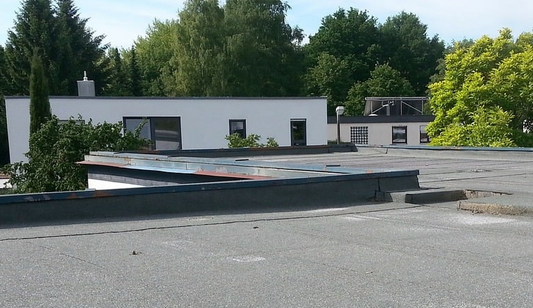Is it realistic or advisable to install PVC single ply roofing without prior experience or training? We take a look.
The idea of saving on installation costs can be appealing, but it's essential to understand the complexities and potential risks involved before embarking on such a project. In this blog post, we will explore the key factors to consider when deciding whether to install a PVC single ply roof system on your own.
Understanding the PVC Single Ply Roof System:
A PVC single ply roof system consists of a flexible, thermoplastic membrane that is applied directly to the roof deck. It offers excellent durability, energy efficiency, and resistance to weathering, making it a popular choice for both residential and commercial buildings. While the materials used in PVC roofing are relatively lightweight and manageable, the installation process requires specific techniques and knowledge to ensure a proper and long-lasting installation.

The Importance of Proper Installation:
Roofing is a critical component of any structure, providing protection from the elements and maintaining the integrity of the building. Improper installation of a PVC single ply roof system can lead to numerous issues such as leaks, premature wear and tear, decreased energy efficiency, and potential damage to the underlying structure. These problems can result in costly repairs and compromised structural stability, negating any potential cost savings from a DIY installation.
Expertise and Experience:
Roofing professionals undergo extensive training and accumulate years of experience to become proficient in their craft. They are familiar with industry best practices, local building codes, and safety protocols. On the other hand, attempting to install a PVC single ply roof system without any prior training or experience can be risky. Lacking the necessary knowledge and skills, you may make mistakes that compromise the performance and longevity of the roof, potentially voiding any warranty on the materials used.
Safety Considerations:
Roofing installations involve working at heights and using specialized tools and equipment. Professionals are trained in safety procedures to prevent accidents and injuries. Without proper training, you expose yourself to the risk of falls, electrical hazards, and other dangers associated with working on roofs. It is crucial to prioritise your safety and that of others around you when considering a roofing project.
Main Installation Methods
There are three primary methods for installing PVC single ply roofing, each with its own complexities:
- Mechanically Attached: The membrane is fastened to the roof deck using screws and plates. Seams are then heat-welded to create a continuous waterproof surface.
- Fully Adhered: Adhesives are used to bond the membrane directly to the substrate. This method demands meticulous surface preparation and careful application of adhesives.
- Induction Welded: Special plates are attached to the deck and then welded to the membrane using induction technology. This method requires specialized equipment and training.
Each method involves precise steps and technical know-how, making experience a critical factor in achieving a successful installation.
Step-by-Step Overview of the Installation Process
To better understand the demands of PVC roofing installation, here’s a high-level overview of the typical process:
- Surface Preparation: The roof deck must be thoroughly cleaned, dry, and free of debris. Any irregularities or moisture can compromise the membrane’s performance.
- Insulation Installation: Insulation boards are laid and secured according to the chosen system and manufacturer’s guidelines.
- Membrane Layout: The PVC membrane is rolled out, aligned, and allowed to relax to prevent wrinkles or buckling.
- Attachment: Depending on the chosen method, the membrane is either mechanically fastened, adhered, or induction welded to the deck.
- Seam Welding: Overlapping seams are heat-welded using a hot air welder to ensure a continuous, waterproof layer.
- Flashing and Detailing: Critical areas like edges, penetrations, and corners are flashed and sealed to prevent leaks.
- Inspection: The entire installation is inspected for proper adhesion, seam integrity, and overall watertightness.
Each step requires attention to detail, specialized tools, and a solid understanding of roofing principles.
Common Mistakes Made by Inexperienced Installers
Without proper training, DIYers are prone to several critical errors that can undermine the roof’s performance:
- Improper Surface Preparation: Failing to clean and dry the deck can lead to poor adhesion and future leaks.
- Incorrect Seam Welding: Inadequate or uneven heat-welding can result in weak seams that are vulnerable to water infiltration.
- Poor Drainage Planning: Neglecting to ensure proper slope and drainage can cause ponding water, accelerating membrane failure.
- Faulty Flashing Installation: Inadequate detailing around penetrations and edges is a leading cause of roof leaks.
- Overstretching or Wrinkling the Membrane: Mishandling the membrane during installation can create vulnerabilities and reduce lifespan.
These mistakes can lead to expensive repairs, water damage, and even premature roof replacement-often negating any savings from a DIY approach.
Hiring a Professional:
Considering the complexity and importance of roof installations, it is strongly recommended to hire a professional roofing contractor with expertise in installing PVC single ply roof membrane. These professionals have the necessary skills, tools, and knowledge to complete the job safely and efficiently. They can assess your specific roofing needs, ensure compliance with building codes, and provide warranties for their work. While it may involve an upfront cost, professional installation offers peace of mind and long-term value.
Conclusion:
While the idea of installing a PVC single ply roof system without any previous training or experience may seem appealing, it is not recommended. Single Ply Roofing is a specialized skill that requires specialised tools, equipment, expertise, knowledge, and adherence to safety protocols. To ensure a proper and durable installation, it is highly recommended to hire a professional roofing contractor. By doing so, you can save yourself time, money, and potential headaches in the long run, while also ensuring the safety and integrity of your home or building




